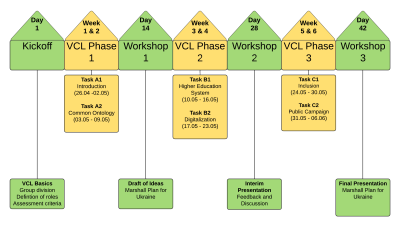جدول المحتويات
Best practices examples - How to plan a VCL?
1. Tools used within the VCL Project
In this section, focus on the tools that are used when conducting a Virtual Collaborative Learning (VCL) project. Digital tools play a critical role in enabling effective collaboration, communication, and project management within a team in an online learning environment.
Different tools can be used in a VCL project. These can range from project management and communication platforms to specialized collaborative working tools. It will be explored how these tools help to support VCL execution and learners achieve their goals.
Best practices tools:
- Miro Board
- Kahoot Quizzes
- MS TEAMS
2. Structure of the project
The structure of a VCL project is an essential component of its successful implementation. It serves as a basic framework for the students' work and can prevent misunderstandings if communication is clear. Since participants are usually physically separated from each other and may have different schedules and commitments, it provides direction and ensures that everyone involved knows what is expected of them, when certain milestones should be reached, and how to collaborate effectively. The structure of a project also helps to use resources efficiently, clarify responsibilities, and facilitate progress monitoring. It serves as a guide for project planning and execution and ensures that the project achieves its goals. Therefore, creating an effective project structure should be an essential part of the VCL course. For Example, International VCL, EPOKA and the structure depicted below.
3. Structure of the tasks:
The structure of the project is also accompanied by the structure of the tasks. Similar to the structure of the project, this should form a common framework and be able to be smoothly integrated into the structure of the project. It has proven to be successful to orientate on the following task structure:
The structure of the project is also accompanied by the structure of the tasks. Similar to the structure of the project, this should form a common framework and be able to be smoothly integrated into the structure of the project.
It has proven to be successful to orientate on the following task structure:
a. Onboarding and common ontology
- A1. It usually takes until all participants of the module have arrived at the platform in their respective group. That is why the first phase of the VCL is dedicated to onboarding. Here, a group contract is written within the group, which specifies general rules of cooperation, expectations, and availabilities. In addition, the roles (see Roles and their Responsibilities) are assigned.
- A2. A common ontology is also established so that professional terminology and commonly used terms are based on the same understanding within the group.
b. Determine the goal of the elaboration and perform analysis
- In the second task block, goals are usually set first, which should be achieved, or which should be the final goal of this VCL. Subsequently, analyses are carried out in line with the objectives, e.g., SWOT analysis or target group analysis.
c. Final planning and presentation of the results
- In the third task block, the planning of the idea is completed. This may include, for example, financial plans or revenue model. In addition, materials for the presentation of the idea are created. This includes theoretical presentation such as marketing strategy and materials or the final presentation in the module.
Blocks 2 and 3 are highly dependent on the objective of the case study. In general, the degree of difficulty and complexity increases from task block to task block, and the tasks build on each other.
